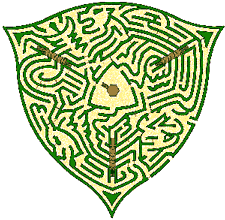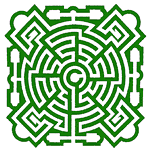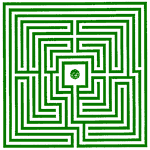This labyrinth typology reference has opened a new browser window. When you have completed your research, simply close the browser window and you will be returned to the Labyrinth Locator.
Preface | Typology | Classical | Roman | Medieval | Contemporary | Mazes | Other
Mazes
With a history stretching back to the late Middle Ages, puzzle mazes, like labyrinths, rapidly became more complex. Developed initially from medieval labyrinths, the earliest mazes in the gardens and palaces of Europe were created by rearranging the walls of a labyrinth to achieve a pathway with choices, often including a number of deadends. While various types of mazes have been proposed and described by modern authorities, five basic types can be clearly identified:
Simply-connected
The majority of early mazes, however complex their design may appear, were essentially formed from one continuous wall with many junctions and branches. If the wall surrounding the goal of a maze is connected to the perimeter of the maze at the entrance, the maze can always be solved by keeping one hand in contact with the wall, however many detours that may involve. These "simple" mazes are correctly known as "Simply-connected."
|
|
| A simply-connected maze design with limited choice of paths, planted at Krenkerup, Denmark, in 1877. |
Multiply-connected
It was not until the early nineteenth century that the principle of isolating the goal of the maze from the perimeter to defeat the "hand-on-wall" method and increase the level of difficulty was truly understood. Any maze with the goal set within an island of barriers, physically unconnected to the rest of the maze, qualifies as "Multiply-connected." The best examples contain islands within islands and, paradoxically, can be developed into very intricate mazes with few dead ends that are nonetheless extremely difficult to solve.
|
|
| The hedge maze at Chevening House, England, c.1820, was one of the first consciously designed to provide a more complex puzzle and thwart the "hand-on-wall" rule for solving mazes. |
Three-dimensional Mazes
Although the majority of traditional mazes with walls of hedges or other materials may appear three-dimensional, the pathway through the maze is essentially only two-dimensional. While the concept of truly three-dimensional mazes has been around since the nineteenth century, they existed only on paper until the early 1980s, with the introduction of bridges and underpasses to add complexity to the panel mazes then popular in New Zealand, Australia and Japan. Bridges are also a common addition to the huge cornfield, or maize mazes that have become popular worldwide since the mid-1990s. The introduction of the third dimension allows the islands of a multiply-connected maze to be totally isolated from each other with the only link via a bridge. In some of these mazes, successful progress to the goal depends on reaching a series of points within the maze in the correct order.
Conditional Movement Mazes
Long established as a theoretical concept, mazes with rules, or conditional movement mazes, have become a reality since the 1980s. The next move is dictated by the overall rules or by instructions given at the visitor's current position, allowing extremely complex puzzles to occupy a very limited space. Constructed in modern materials and rarely aesthetically pleasing, these mazes offer an entertaining intellectual challenge and have proven to be popular in educational contexts, particularly to illustrate mathematical and scientific concepts.
Interactive Mazes
High-tech mazes where the design responds to the actions of visitors are an increasingly common feature at amusement parks and other tourist attractions. They incorporate computer-timed barriers and other innovative devices such as motion sensors and mechanisms that determine the physical characteristics of the walker. Interactive mazes first appeared in the closing years of the twentieth century and no doubt herald future leading-edge maze design.
 |
| A modern maze with interactive features at Drielandenpunt near Vaals in the Netherlands, designed by Adrian Fisher. |

